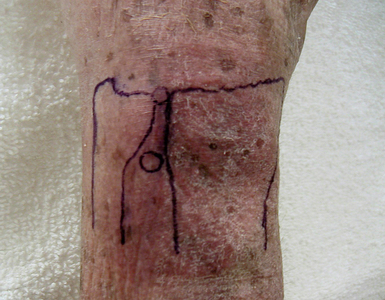CHAPTER 6 Arthroscopy of the Distal Radioulnar Joint
Anatomy and Biomechanics
The DRUJ is a trochoid diarthrodial articulation that allows both rotation and translation during normal forearm motion. The overall dimensions of the sigmoid notch average 15 mm in the transverse plane and 10 mm in the coronal plane. Its dorsal bony rim is typically acutely angled, whereas the volar rim is more rounded and is frequently augmented by a cartilaginous lip. The shape of the notch varies considerably in both planes, which plays a role in both joint stability and ease of arthroscopic access.1 Due to its relatively shallow and incongruent articulation, the DRUJ relies strongly on the soft tissues for stability. The structures that contribute to DRUJ stability are the pronator quadratus, extensor carpi ulnaris (ECU), interosseous membrane (IOM), DRUJ capsule, and components of the triangular fibrocartilage complex (TFCC).2
During forearm rotation, DRUJ translation occurs because the sigmoid notch is shallow (with a radius of curvature 50% greater than that of the ulnar head). At the extremes of pronation and supination, the ulnar head slides palmarly and dorsally in the sigmoid notch (respectively)—resulting in only 2 to 3 mm of articular contact area at the rims.3 Although DRUJ motion has a substantial translational component (with a changing axis of rotation), its instant axis generally passes near the center of the ulnar head—moving dorsally with pronation and palmarly with supination. The ulnar head serves as the seat for the sigmoid notch, around which the radius rotates.3 The amount of articular cartilage that covers the head varies from a 50-degree to a 130-degree arc.
Surgical Technique
A regional or general anesthetic is administered. The patient is positioned supine on the operating table. An upper-arm tourniquet is applied over cotton padding. The elbow is flexed to 90 degrees and the upper extremity is mounted in a traction tower using finger traps applied to the long and ring fingers. Placing the wrist in full supination facilitates access to the DRUJ, unless the joint becomes excessively tight in this position. In neutral rotation the opposing surfaces of the sigmoid notch and the ulnar head are congruent, whereas in full supination the opposing surfaces have only a marginal contact area of 2 to 3 mm.4
A distal DRUJ portal can be established for instrumentation and improved visualization of the ulnar dome and TFCC. This portal enters between the TFCC central disc and the head of the ulna (Figure 6.1). It should first be localized with a needle while viewing with the arthroscope in the proximal portal.5 The portal is typically used for instruments such as shavers, graspers, and radiofrequency devices.
< div class='tao-gold-member'>
Stay updated, free articles. Join our Telegram channel

Full access? Get Clinical Tree









